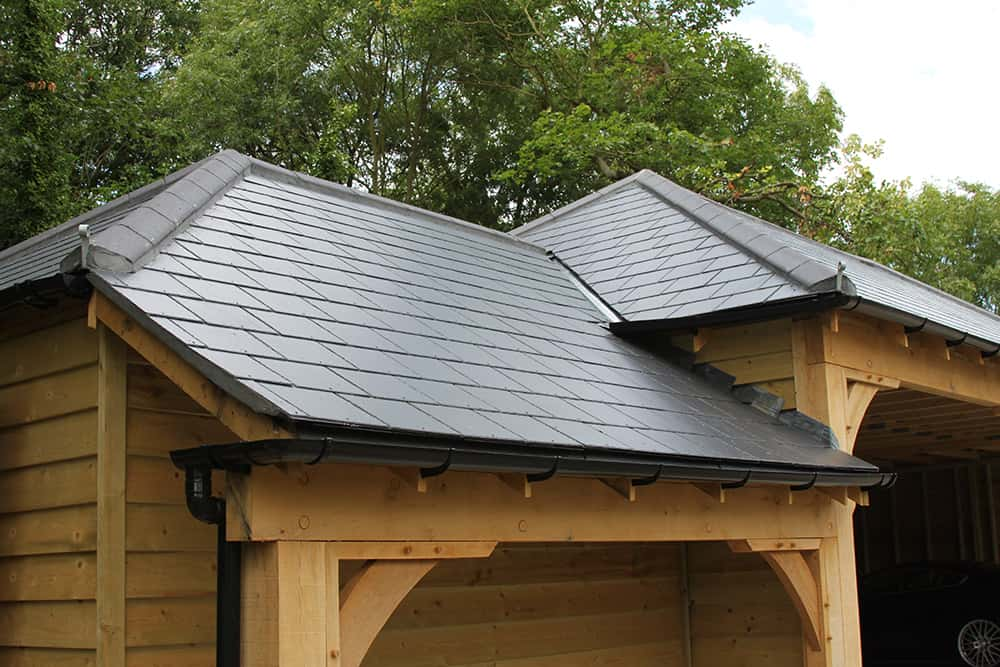A hip roof, also known as a hipped roof or barn hip roof, is a type of roof design commonly found on stables, barns, and other agricultural buildings. It is recognisable for its distinctive shape, which features slopes on all sides that meet at a ridge or a peak.
The hip roof design is different from a gable roof, which has two sloping sides that meet at a gable end. In contrast, a hip roof has slopes on all sides, creating a more symmetrical and pyramid-like appearance. The sides of the roof, called hip rafters, slope upward from the eaves to the ridge or peak. The hip rafters are typically supported by a framework of horizontal beams called purlins.
The hip roof design offers several advantages for wooden stable buildings and other structures. Here are some of the key ones to consider:
Stability and durability
The primary advantage of a hip roof design is its stability and durability. The sloping sides of the roof distribute the weight evenly, improving the overall structural integrity and therefore, provides excellent resistance to wind and other weather elements. This makes it particularly suitable for agricultural structures like stables and barns, where protection of livestock, crops, and equipment is essential. The hip roof design also allows for better drainage of rainwater and snow, reducing the risks of leaks and structural damage.
Efficient drainage
The hip roof’s slopes on all sides facilitate efficient drainage of rainwater and melting snow. The water runs off easily without pooling or causing excessive stress on the structure. This efficient drainage reduces the risks of leaks, water damage, and rot, which is particularly important for timber buildings that are more susceptible to moisture-related issues.
Enhanced ventilation
The shape of the hip roof allows for enhanced natural ventilation. The four sloping sides create a chimney effect, facilitating the upward movement of warm air and promoting air circulation within the building. This ventilation helps in regulating temperature, reducing moisture build up, and providing a healthier environment for livestock and stored goods.
Increased space
The design of a hip roof maximises usable space within the building. The absence of vertical gable ends creates more headroom and allows for increased storage capacity or loft space. This is particularly advantageous in stable buildings where additional space may be required for equipment, feed, or other materials.
Architectural appeal
The hip roof design is aesthetically pleasing and has a timeless charm, often associated with traditional farm structures. It adds character and visual appeal to timber buildings, blending well with rural landscapes. The symmetrical and pyramid-like shape of the hip roof can enhance the overall architectural design and create a sense of harmony.
Longevity
A properly constructed hip roof using quality materials can have a long lifespan. The durable design, along with regular maintenance, can help the roof withstand the test of time. This longevity is beneficial for stable buildings and other timber structures, providing reliable protection and reducing the need for frequent repairs or replacements.
The construction of a hip roof design requires careful planning and craftsmanship. It involves a complex system of rafters, purlins, and other structural components. Additionally, the roof’s shape may vary depending on the specific design and requirements of the building.
Overall, the hip roof design is a popular choice for stables, and other agricultural buildings due to its functional benefits, aesthetic appeal, and historical association with traditional farm structures. Consulting with a professional in timber construction is advisable to ensure the roof meets all necessary criteria for your specific building project.
At National Timber Buildings, we have in-house designers who will be happy to create the perfect stable of timber building for you. Our design process is simple, but thorough and we can either work to your specifications and needs to put together a design that will more than satisfy your requirements, or if you know exactly what you want from your timber-frame barn, or other wooden buildings, we will work to your requirements.

Get in touch
Want to know more about choosing low-cost, high-quality stables? We’re happy to answer all your questions. Call 01233 884502, email info@nationalstables.co.uk or send us a message and we will respond ASAP.




